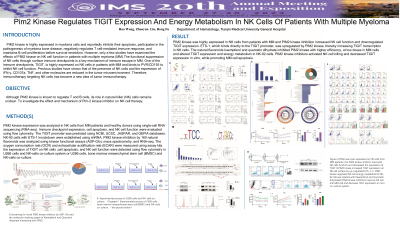Myeloma Novel Drug Targets and agents
Poster Session 2
P-221: PIM2 kinase regulates TIGIT expression and energy metabolism in NK cells from multiple myeloma patients
Thursday, September 28, 2023
12:30 PM - 1:30 PM EEST


Hao Wang, MD
Department of Hematology
Tianjin Medical University General Hospital
Tianjin, Tianjin, China (People's Republic)
Introduction: PIM2 kinase is highly expressed in myeloma cells and reportedly inhibits their apoptosis,participates in the pathogenesis of myeloma bone disease, negatively regulates T cell-mediated immune response, and maintains B cell proliferation before survival restriction. However, only a few studies have examined the effects of PIM2 kinase on NK cell function in patients with multiple myeloma (MM).The functional suppression of NK cells through surface immune checkpoints is a key mechanism of immune escape in MM. One of the immune checkpoints, TIGIT, is highly expressed on NK cells in patients with MM and binds to PVR/CD155 to inhibit NK cell function. Previous studies have shown that of the presence of NK cells and the expression of IFN-γ, CD107a, TNF, and other molecules are reduced in the tumor microenvironment. Therefore, immunotherapy targeting NK cells has become a new idea of tumor immunotherapy.Although PIM2 kinase is known to regulate T and B cells, its role in natural killer (NK) cells remains unclear.To investigate the effect and mechanism of Pim-2 kinase inhibitor on NK cell therapy.
Methods: PIM2 kinase expression was analyzed in NK cells from MM patients and healthy donors using single-cell RNA sequencing (RNA-seq). Immune checkpoint expression, cell apoptosis, and NK cell function were evaluated using flow cytometry. The TIGIT promoter was predicted using NCBI, UCSC, JASPAR, and GEPIA databases. NK-92 cells with ETS-1 knockdown were established using shRNA. PIM2 kinase inhibition by 160 natural flavonoids was analyzed using kinase functional assays (ADP-Glo), mass spectrometry, and RNA-seq. The oxygen consumption rate (OCR) and extracellular acidification rate (ECAR) were measured using assay kits. the expression of TIGIT on NK cells ,cell apoptosis, and NK cell function were detected using flow cytometry in U266 cells and NK-cells co-culture system or U266 cells, bone marrow mesenchymal stem cell (BMSC) and NK-cells co-culture.
Results: PIM2 kinase was highly expressed in NK cells from patients with MM and PIM2 kinase inhibition increased NK cell function and downregulated TIGIT expression. ETS-1, which binds directly to the TIGIT promoter, was upregulated by PIM2 kinase, thereby increasing TIGIT transcription in NK cells. The natural flavonoids kaempferol and quercetin dihydrate inhibited PIM2 kinase with higher efficiency, at low doses in MM cells and altered TIGIT expression and energy metabolism in NK-92 cells. PIM2 kinase inhibitors activated NK cell killing and decreased TIGIT expression in vitro, while promoting MM cell apoptosis.
Conclusions: PIM2 kinase regulates NK cell anti-myeloma activity by modulating TIGIT expression and energy metabolism.
Methods: PIM2 kinase expression was analyzed in NK cells from MM patients and healthy donors using single-cell RNA sequencing (RNA-seq). Immune checkpoint expression, cell apoptosis, and NK cell function were evaluated using flow cytometry. The TIGIT promoter was predicted using NCBI, UCSC, JASPAR, and GEPIA databases. NK-92 cells with ETS-1 knockdown were established using shRNA. PIM2 kinase inhibition by 160 natural flavonoids was analyzed using kinase functional assays (ADP-Glo), mass spectrometry, and RNA-seq. The oxygen consumption rate (OCR) and extracellular acidification rate (ECAR) were measured using assay kits. the expression of TIGIT on NK cells ,cell apoptosis, and NK cell function were detected using flow cytometry in U266 cells and NK-cells co-culture system or U266 cells, bone marrow mesenchymal stem cell (BMSC) and NK-cells co-culture.
Results: PIM2 kinase was highly expressed in NK cells from patients with MM and PIM2 kinase inhibition increased NK cell function and downregulated TIGIT expression. ETS-1, which binds directly to the TIGIT promoter, was upregulated by PIM2 kinase, thereby increasing TIGIT transcription in NK cells. The natural flavonoids kaempferol and quercetin dihydrate inhibited PIM2 kinase with higher efficiency, at low doses in MM cells and altered TIGIT expression and energy metabolism in NK-92 cells. PIM2 kinase inhibitors activated NK cell killing and decreased TIGIT expression in vitro, while promoting MM cell apoptosis.
Conclusions: PIM2 kinase regulates NK cell anti-myeloma activity by modulating TIGIT expression and energy metabolism.
